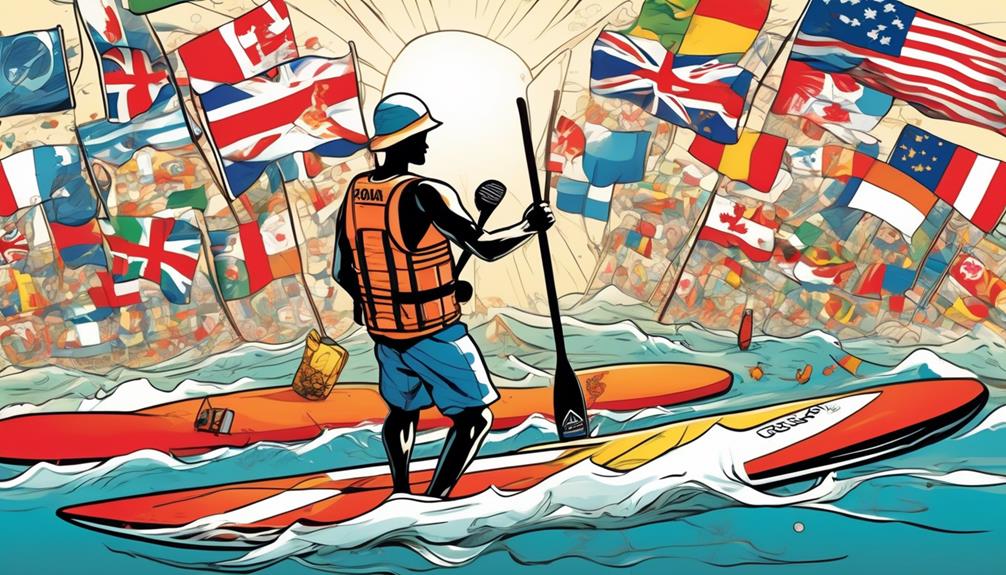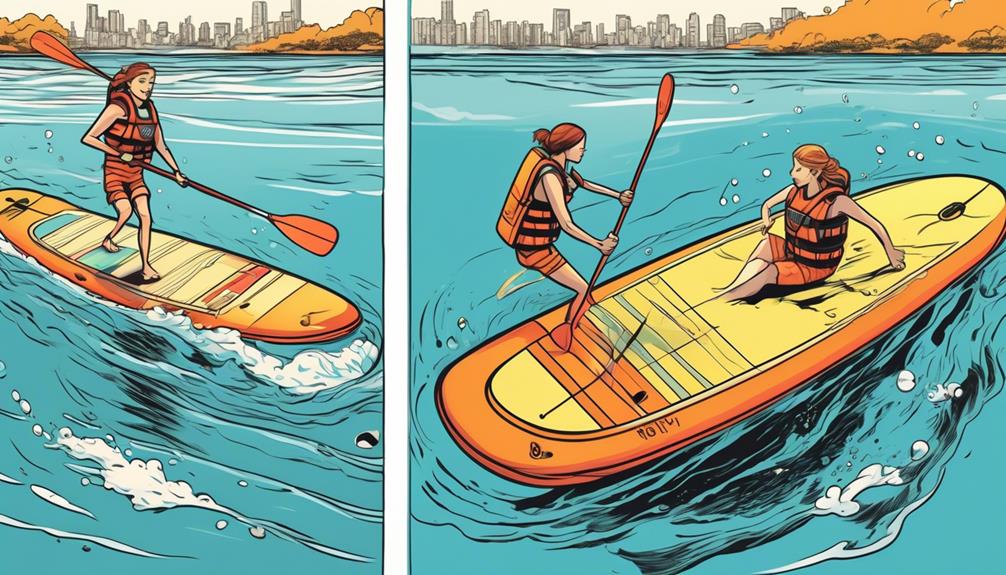Is the ocean just a big playground or a stark reminder of nature's unforgiving power? If you're like me, spending loads of time cruising on an inflatable paddle board, you've probably pondered the real need for a life jacket.
It's tempting to think it's all easy-going, riding on what's basically a floating cushion. But, here's the deal: local laws are a mixed bag, water conditions can flip like a switch, and there are tons of myths about how safe paddleboarding really is.
So, do you actually need a life jacket? I've looked into it, and it's not just about following your gut. I'm talking real legal requirements, the unpredictable nature of different water bodies, and busting myths that could be putting us at risk. I'll be straight with you – it's not just a yes or no question.
Stick with me as we break down the facts and sift through the data, so you can hit the water both safe and sound.
Key Takeaways
- Local laws regarding life jackets for inflatable paddle boards vary widely, so it's important to understand and comply with the regulations in your area.
- Assessing water conditions and risks before paddle boarding is crucial for safety. Consider weather forecasts, seasonal changes, and personal observation of the water.
- Debunk common myths, such as the misconception that being a good swimmer or having an inflatable paddle board guarantees safety without a life jacket.
- Prioritize personal safety over leisure and confidence. The majority of boating fatality victims did not wear life jackets, and drowning victims were often not wearing one. Wearing a life jacket reduces the risk of drowning and increases chances of survival.
Understanding Local Laws

Before you grab your paddle and head out, let's talk local laws on life jackets for inflatable paddle boards. I'll be honest, the variation is wild, and as someone who thrives on data and efficiency, it's a bit of a headache. You're probably wondering if these laws are genuinely about safety or just regulatory red tape. Well, you're not alone.
I've looked into the regulations in different areas, and the inconsistency is striking. Some places mandate wearing a life jacket at all times, while others require having one on board but not wearing it. Then, there are locations where it's seemingly at your discretion. For those of us who favor innovation and practicality, this scattered approach is more than just annoying—it's a barrier to enjoying the sport.
When navigating these regulatory waters, it's crucial to keep a keen eye on the details. Yes, I'm all in for safety. But shouldn't we strive for smart, adaptable regulations that take into account the vast differences in water conditions and user experiences? The reality is, water sports are evolving rapidly, and it's about time regulations do the same.
Let's break it down with some real-world examples. In California, for instance, the law requires anyone under 13 on a moving recreational vessel to wear a life jacket. Meanwhile, in Florida, the rule is under 6 years old. These differences aren't just bureaucratic nuances—they reflect a deeper need for regulations that resonate with the actual risks and user experiences in different locales.
What does this mean for you? Well, beyond just staying on the right side of the law, it's about making informed choices that enhance safety without compromising the joy of paddling. It's about pushing for regulatory updates that align with modern practices and technologies in water sports.
Assessing Water Conditions
Why trust local water safety guidelines without checking the actual conditions? It's a question you should be asking yourself, especially if you're into paddle boarding like I am. Sure, these guidelines give us a starting point, but they can't keep up with the ever-changing nature of water. My experience has taught me the importance of doing my own condition assessments.
Let's talk facts. Water conditions are anything but static. That peaceful lake in the morning? It can get choppy by the afternoon. If you're just going by the book, you're missing out on the real picture. I've witnessed weather flip from sunny to stormy in no time, turning what was a manageable current into a beast. This isn't about just following the law; it's about your safety.
I've made it a point to check weather forecasts, get a grip on seasonal changes, and really watch the water before I even think about getting my board out. This isn't about being a weather geek; it's about using common sense. Seeing the water getting rough or a storm brewing? I make sure I'm prepared, even if it means wearing that life jacket I'm not fond of.
Embracing safety innovations doesn't mean throwing out all the rules. It's about being smart and adapting to what's actually happening. Doing a water condition assessment isn't just another checkbox; it's a must-do. It's all about making decisions that match up with the guidelines and what you're seeing with your own eyes.
Let me give you a data-driven example. Studies have shown that weather conditions can drastically change water safety risks. For instance, wind speeds of over 15 mph can significantly increase the likelihood of choppy water, making paddle boarding more dangerous. By checking the forecast and observing the water, I'm making an informed decision based on statistical risks, not just a gut feeling.
In essence, assessing water conditions before paddle boarding isn't just about compliance. It's about using data and personal observation to ensure you're making the safest choices. It's a practical approach that blends regulations with the unpredictable nature of water, tailored to keep you safe.
Debunking Common Myths

Alright, let's get straight to the point. I've seen a lot of you debating life jackets on inflatable paddle boards, and it's high time we cleared up some misconceptions with hard facts and personal insights.
First up, the whole 'I'm a good swimmer, I don't need a life jacket' spiel. Listen, I've been swimming since I could walk, but I've also been caught off guard by a sudden cramp or unexpected currents. The data backs this up too. According to the U.S. Coast Guard's 2020 Recreational Boating Statistics, a significant number of drowning victims were reported as strong swimmers. Your skills are admirable, but they're not a shield against every possible scenario. Wearing a life jacket isn't about doubting your abilities; it's about playing it smart with an extra layer of safety.
Moving on to the 'inflatable paddle boards are unsinkable' myth. Yeah, these boards are designed to float, but they're not the Titanic – and look how that turned out. Manufacturing defects, accidental punctures, or valve failures can and do happen. A life jacket serves as your personal buoyancy aid, ensuring you stay afloat even if your board doesn't. It's your first line of defense in an unpredictable environment.
Now, let's talk about the 'life jackets are too bulky' myth. This isn't the 90s. Modern life jackets are designed for paddle sports with both safety and mobility in mind. They're sleek, they're comfortable, and most importantly, they don't impede your movement. I've paddled miles in mine and can vouch for the fact that the right life jacket feels like a second skin, not a bulky hindrance.
Lastly, the idea that life jackets are just for kids is a dangerous assumption. Water safety is age-agnostic. No matter how old or experienced you are, the water can surprise you. A life jacket is a universal safety tool, non-negotiable for everyone. The U.S. Coast Guard reports consistently highlight that the majority of boating deaths occur among adults, often seasoned water enthusiasts who overestimated their immunity to accidents.
Prioritizing Personal Safety
You might think slapping on a life jacket for a leisurely paddle board session is excessive, but let me drop some hard truths on you. The water's unpredictability doesn't give a damn about how experienced or strong a swimmer you think you are. It's a level playing field out there, and the stats back this up.
First off, did you know that according to the U.S. Coast Guard's 2020 Recreational Boating Statistics, a whopping 79% of boating fatality victims drowned, with 86% of those not wearing life jackets? These aren't just numbers; they're a wake-up call. When you're out there on your paddle board, thinking you're too good for a life jacket, remember these stats. The water's unpredictability isn't a myth; it's a reality that doesn't care about your confidence level.
Let's talk about sudden weather changes or water conditions. You can't control these, and they don't send a heads-up. You could be enjoying smooth sailing one minute and battling to stay afloat the next. This isn't fear-mongering; it's preparing for the inevitable. Fatigue is another silent adversary. Even if you're Michael Phelps in disguise, fatigue can and will hit you unexpectedly. That life jacket? It's not just a flotation device; it's your lifeline when your muscles decide they've had enough.
And accidents? They're called accidents for a reason – because they happen out of the blue. A peaceful day on the water can turn into a nightmare scenario in seconds. You're not just keeping yourself safe by wearing a life jacket; you're ensuring you're not a part of next year's grim statistics.
Oh, and if you're one of those 'rules are meant to be broken' types, consider this: in many areas, wearing a life jacket isn't a choice; it's the law. Ignoring this can hit your wallet through fines, or worse, put your life at risk.
So, let's cut to the chase. Thinking you're above wearing safety gear because you're an experienced paddle boarder isn't just arrogant; it's dangerous. Modern life jackets are designed with comfort and mobility in mind, so the old excuses don't float anymore. Prioritizing safety isn't an overreaction; it's common sense backed by data. It's about acknowledging that no matter how skilled you are, the water will always be an unpredictable force.
Play it smart, play it safe, and don't become a statistic. Remember, safety isn't just about you; it's a responsibility towards everyone who cares about you.

